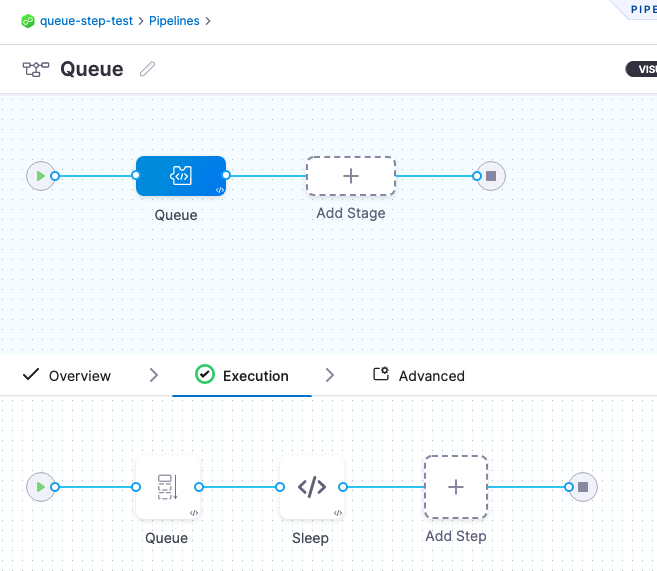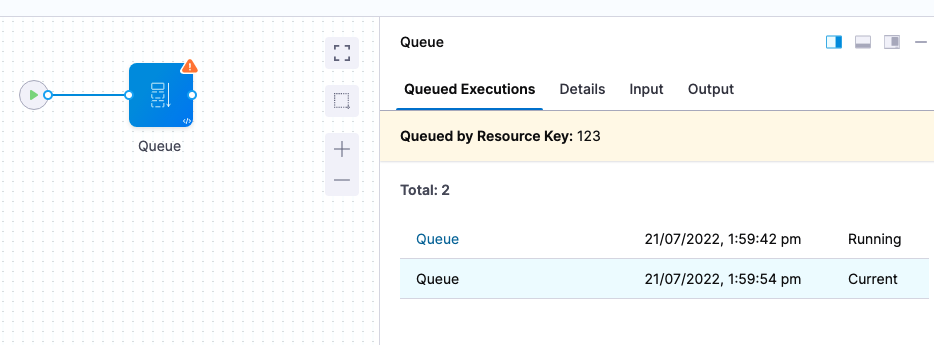Control resource usage with Queue steps
This topic describes how to use the Queue step to control the access order to the resources Harness requests during a deployment and prevent multiple pipelines from requesting the same resources at the same time.
For example, two Pipelines might be deploying artifacts to a single Kubernetes namespace simultaneously. To avoid collision, and queue deployments, you add a Queue step to each Pipeline.
When the first Pipeline completes, it releases the lock and the second Pipeline can continue.
Queue steps can be used on different Pipelines or even multiple executions of the same Pipeline.
In this topic, you will learn how to use the Queue step to control the order in which Pipelines access resources.
Harness provide multiple options for controlling resource usage and protecting capacity limits. See Controlling Resource Usage with Barriers, Resource Constraints, and Queue Steps.
Add Queue Steps
- In the stage Execution, determine where you want to queue deployments and click Add Step.
- In Flow Control, click Queue.
- Enter a name and timeout for the Queue step.
- In Resource Key, enter a unique key. This is the same key you will add to the Queue steps in other Pipelines.
- The Resource Key supports Fixed Values, Runtime Inputs, and Expressions. See Fixed Values, Runtime Inputs, and Expressions.
- In Run next queued execution after completion of, select one of the following:
- Pipeline: the entire Pipeline must complete before the queued Pipelines can deploy.
- Stage: the current Stage must complete before the queued Pipelines can deploy.
Queue steps can be used on different Pipelines or even multiple executions of the same Pipeline.
Advanced settings
In Advanced, you can use the following options:
Test
Let's look at a simple example to show how Queue steps work.
Here's the YAML for the Pipeline that contains a Custom Stage with a Queue Step followed by a Shell Script step that runs a Bash sleep 30.
You can copy it and paste it into your Harness Project. You simply need to update the projectIdentifier and orgIdentifier settings to match your current Project and Org.
pipeline:
name: Queue
identifier: Queue
projectIdentifier: queuesteptest
orgIdentifier: default
tags: {}
stages:
- stage:
name: Queue
identifier: Queue
description: ""
type: Custom
spec:
execution:
steps:
- step:
type: Queue
name: Queue
identifier: Queue
spec:
key: "123"
scope: Pipeline
timeout: 10m
- step:
type: ShellScript
name: Sleep
identifier: Sleep
spec:
shell: Bash
onDelegate: true
source:
type: Inline
spec:
script: sleep 30
environmentVariables: []
outputVariables: []
executionTarget: {}
timeout: 10m
tags: {}
When you're done the Pipeline will look like this:

Open the Queue step.
You can see Run next queued execution after completion of is set to Pipeline. That means that the Pipeline must finish deploying before any other queued Pipeline executions can proceed.
Now let's run this Pipeline twice in a row quickly.
The first run of the Pipeline will run without queuing but the second run of the Pipeline is queued until the first one is complete.
Here's the first run of the Pipeline. It shows the Pipeline execution running (Running) and the other Pipeline execution queued.

You can click the name of the queued Pipeline to jump to its execution.
Here's the second run of the Pipeline:

You can see the Pipeline execution is queued (Current) and you the Pipeline execution that is running.
This example used multiple executions of the same Pipeline, but if a Queue step is added to another Pipeline and uses the same Resource Key, the same queuing process is applied to that Pipeline.
Here's another Pipeline, queue 2, with the same Queue step Resource Key. You can see it waiting for the Queue Pipeline to complete.

Queue Step Scope
Queue steps are account-wide. This ensures that if a Queue step is placed in one Pipeline, it will restrict any other Pipeline in the account from using resources until it is safe to use.
Barriers, Resource Constraints, and Queue Steps
Harness has a number of ways to control deployments and resource usage. It's important to understand their differences.
See Controlling Resource Usage with Barriers, Resource Constraints, and Queue Steps.
When to Queue
Queue steps can be added anywhere in your Stage, so it's important to add them whenever the resource you want to protect is being used.
For example, if Pipeline A will perform some Terraform provisioning and Pipeline B will deploy to the provisioned infrastructure, you will want to place the Queue step before the Terraform Apply step in Pipeline A, and before the deployment step in Pipeline B (such as a Kubernetes Rolling step).